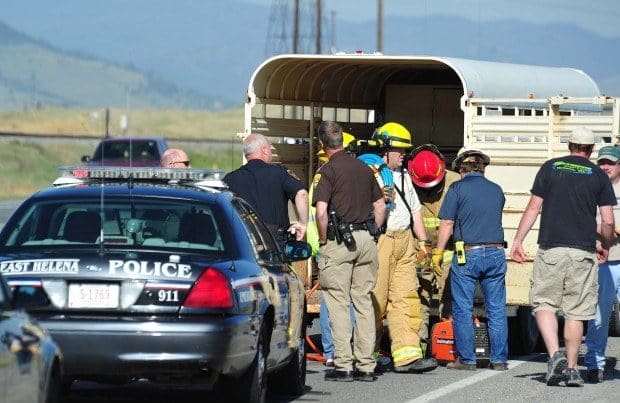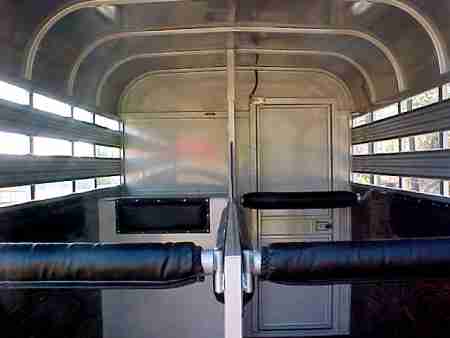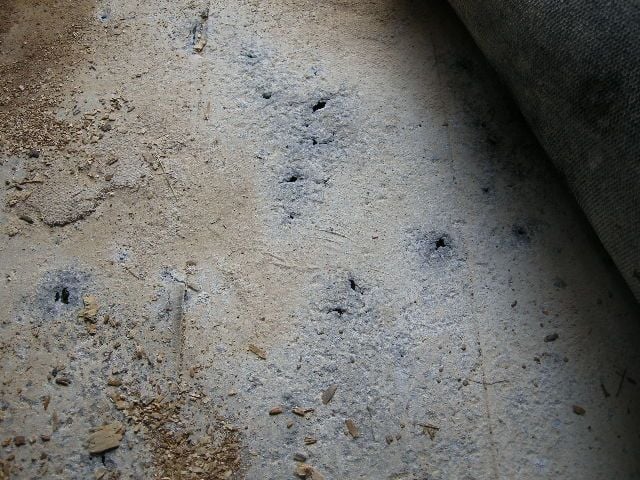Horse Trailer Safety: Never Buy a Trailer with These Dangerous Features
I’ll never forget the day that I saw a horse flip backwards inside a horse trailer. It was terrifying. I remember a feeling of helplessness and worry as the panicked mare desperately tried to free herself from the trailer’s metal interior. This was the day that I learned very quickly how important it was to have the right horse trailer safety features.

I was following the trailer in my family’s vehicle when we spotted a horse hoof emerge from the side rear window of the trailer. Realizing the danger of the situation, we floored the gas pedal, blared the horn, and signaled to our friends to pull over.
Everyone rushed to the rear of the trailer to lower the back ramp and received a startling sight. Instead of the expected three horse rumps standing side-by-side, we saw a horse’s head lull out onto the ramp. The left positioned Arabian mare had completely flipped over and was laying on her back in the cramped trailer stall.
There was blood everywhere. She was not moving.
The gelding beside the stricken mare shifted his feet nervously and stepped on the top portion of the downed mare’s back jolting her into motion. She began to frantically scramble her hooves trying to extricate herself from the metal cell.

Once the terrified mare was free of the trailer, we discovered to our great relief that the majority of the blood was coming from one deep cut on her lip. Otherwise, she was mostly unharmed.
This incident will forever be burned in my memory as an example of a trailer ride gone wrong. Now, I understand that much worse could have happened. I’ve read of horses falling through the floors of moving trailers, kicking delicate legs through thin metal walls, and getting trapped inside twisted highway wreckage.
Incidents like these highlight the importance of choosing a trailer that has the right type of safety features to protect horses on the road. Along with Double D Trailers owner, Brad Heath, I have compiled this list of horse trailer safety hazards that you should avoid at all cost. These are the types of horse trailer design flaws that can lead to very serious accidents.
Horse Trailer Design Flaws: Partitions and Interior
Butt and Chest Bars – Be on the lookout for poorly design butt and chest bars. A horse could get trapped underneath a butt bar and cause serious injury in the scramble to stand back up. Alternatively, they can get a leg over top of a chest bar so that it’s nearly impossible to release with their weight on top. Make sure you look for butt and chest bars that have a removable pit that can release even with the full weight of the horse on the bar.
Weak Interior Dividers – As with butt and chest bars, it is important that interior dividers can withstand some serious force from a panicked horse or during an accident. Stay away from aluminum interior dividers because the weak metal tends to break at the welding points resulting in sharp jagged edges. Instead, look for a much stronger option. Steel is strong but can rust, so your best bet is a composite material like Z-Frame technology to provide long-lasting durability.

Noisy Interiors – Another way to minimize stress for your horse is to rid the trailer of all rattles and creaking during travel. Any trailer that uses bolts, screws, or mechanical fasteners will have a metal on metal scraping noise while the trailer is in motion. Instead, look for trailers that use a 3M chemical bonding system (also known as “tape”) for a quieter ride and secure seal.

Too Little Interior Padding – If you encounter a trailer with little or no interior padding, you should walk away immediately. Look for padding that is at least 1” thick on all dividers and walls. Better yet, go with 2” padding from Double D Trailers.
Walls, Floor, and Roofing Hazards

Aluminum Flooring – Aluminum isn’t any better to use on the floor of a trailer. Over time it can actually rust and weaken (see picture to the right). The last thing you want is for your horse to drop a leg through a hole in a horse trailer floor. In addition, aluminum flooring transfers a great deal of heat and vibration up from the road and can cause excessive fatigue on your horse’s legs. Instead, look for wood or synthetic Rumber flooring for strength and minimal heat and vibration transfer.

Weak Rubber Wall Linings – Most trailer manufacturers only use a rubber lining on the walls that is 3/16” thick. Pawing horses can pull this away from the wall exposing sharp metal fasteners. Instead, look for wall linings that are at least 30” from the flooring and made of a petroleum product that is at least 1/2” thick. SafeKick walls from Double D Trailers are a great option because they are thick, well secured, and designed to protect your horse from injury.
Loading and Unloading Dangers

This narrow opening is scary for many horses who see it as a dark hole with no route for escape. Even if you’ve trained your horse to tolerate this type of trailer, he may still be experiencing elevated levels of the stress hormone cortisol. Stressed horses are more susceptible to infections like shipping fever. In addition, in an emergency situation, you will have limited access to your horse with this type of trailer configuration. A panicked horse trying to rush through this narrow escape door could easily run over a handler.
Instead, look for a trailer with multiple escape doors on the front and side of the trailer. Better yet, look into models like the Double D Trailers SafeTack design where the rear tack storage area can be swung out like a second door. This will eliminate the problem of a narrow door and limited access.
Each horse person is going to have their own personal experiences that help mold the type of safety practices they use on a daily basis. It is our job to learn from these experiences to make the best decisions for the health and well-being of our horses and family members. Hopefully this list of dangerous trailer features will provide some guidance for the next time you go to purchase a new trailer.
Questions: What experiences have you had that highlight the need for proper horse trailer safety features?


